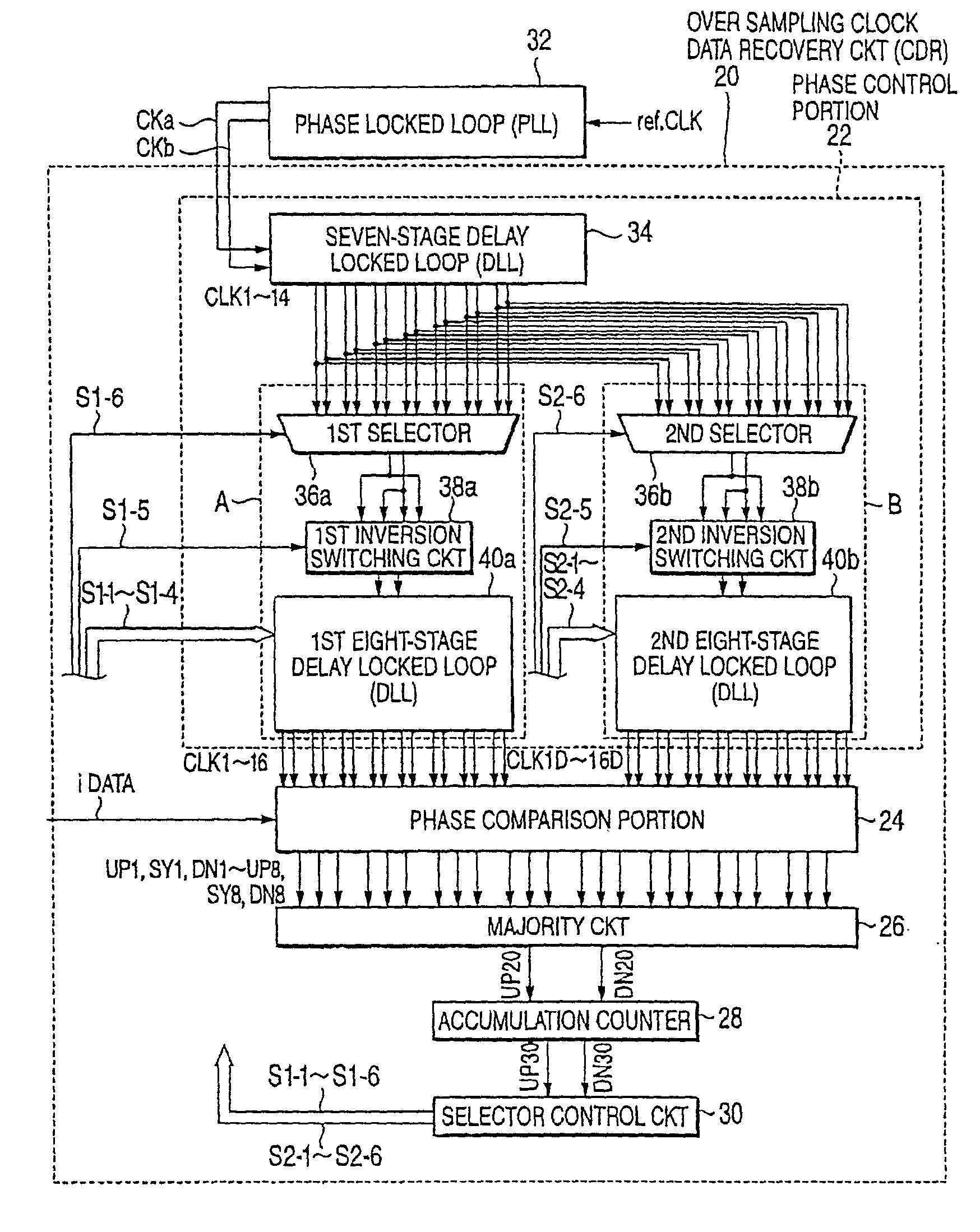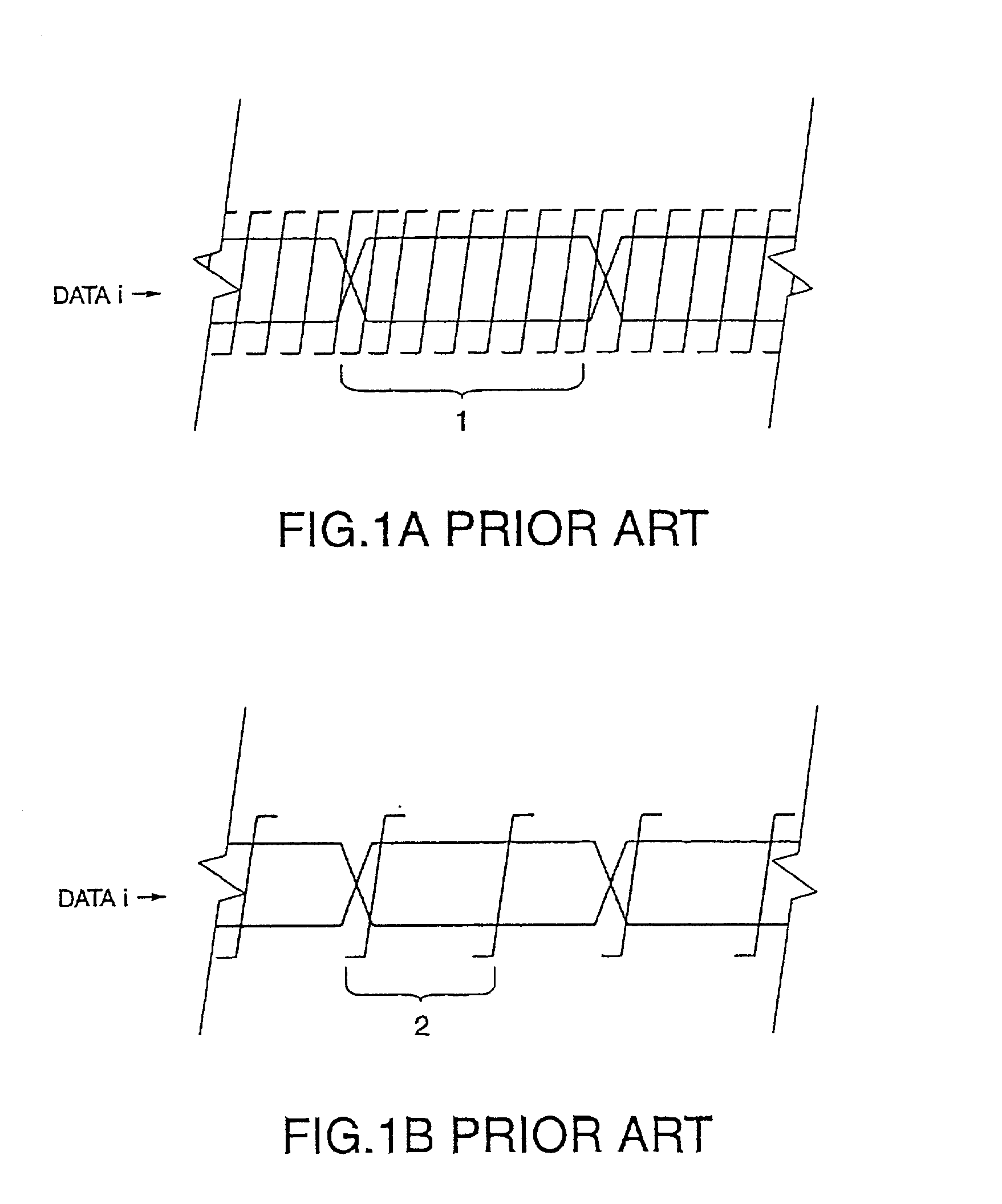Oversampling clock recovery having a high follow-up character using a few clock signals
a clock signal and recovery circuit technology, applied in pulse manipulation, pulse technique, synchronisation signal speed/phase control, etc., can solve the problems of difficult to make oscillation frequency, difficult to meet the request of high-speed in clock recovery circuit and phase locked loop, and difficult to cope with a further high-speed of data transmission. , the effect of high follow-up character and high resolution
- Summary
- Abstract
- Description
- Claims
- Application Information
AI Technical Summary
Benefits of technology
Problems solved by technology
Method used
Image
Examples
first embodiment
[0064]Referring to FIGS. 2A, 2B, 2C, 2D, 2E, and 2F, the description will proceed to an oversampling clock recovery method according to a first embodiment of this invention. FIGS. 2A through 2F are time charts showing waveforms for use in describing the oversampling clock recovery method according to the first embodiment of this invention.
[0065]The illustrated oversampling clock recovery method generates three-phase clock signals CLKa, CLKb, and CLKc having non-uniform intervals for one bit of an input data i. In addition, clock signals CLKb, CLKc, and CLKd also are three-phase clock signals having non-uniform intervals for the one bit of the input data i. Four-phase clock signals CLKa, CLKb, and CLKc, and CLKd are called first through fourth clock signals, respectively. The oversampling clock recovery method comprises the steps of sampling the input data i using the four-phase clock signals CLKa, CLKb, CLKc, and CLKd, of detecting phase differences between the input data i and the ...
second embodiment
[0078]Referring to FIGS. 3 through 10, the description will proceed to an oversampling clock data recovery circuit according to a second embodiment of this invention. FIG. 3 is a block diagram showing the oversampling clock data recovery circuit according to the second embodiment of this invention.
[0079]The first embodiment does not describe about realization of circuitry. The illustrated oversampling clock data recovery circuit (which may be called “CDR” for short) is a circuit for implementing the oversampling clock recovery method of the first embodiment. In the second embodiment, description exemplifies a case of dealing with an 8-bit serial input data having a data rate of 2.5 Gbps and a differential clock signal having a clock frequency of 312.5 MHz (a period of 3200 ps).
[0080]The oversampling clock recovery circuit according to the second embodiment generates, as first multi-phase clock signals, fourteen multi-phase clock signals CK1 to CCK14, as second multi-phase clock sign...
third embodiment
[0224]Referring to FIGS. 11A, 11B, 11C, 11D, 11E, 11F, 11F, and 11H, the description will proceed to an oversampling clock recovery method according to a third embodiment of this invention. FIGS. 11A to 11H are time charts showing waveform for use in describing the oversampling clock recovery method according to the third embodiment of this invention.
[0225]The illustrated oversampling clock recovery method is different from the oversampling clock recovery method according to the first embodiment and detects lag / lead of clock signals in reference with an input data i by sampling the input data using six-phase clock signals CLKe, CLKf, CLKg, CLKh, CLKi, and CLKj where four leading clock edges correspond to one bit of the input data i. The six-phase clock signals CLKe to CLKj are called first through sixth clock signals, respectively.
[0226]A phase interval between the first clock signal CLKe and the fifth clock signal CKLi is equal to a length of the one bit of the input data i. The fi...
PUM
 Login to View More
Login to View More Abstract
Description
Claims
Application Information
 Login to View More
Login to View More - R&D
- Intellectual Property
- Life Sciences
- Materials
- Tech Scout
- Unparalleled Data Quality
- Higher Quality Content
- 60% Fewer Hallucinations
Browse by: Latest US Patents, China's latest patents, Technical Efficacy Thesaurus, Application Domain, Technology Topic, Popular Technical Reports.
© 2025 PatSnap. All rights reserved.Legal|Privacy policy|Modern Slavery Act Transparency Statement|Sitemap|About US| Contact US: help@patsnap.com



